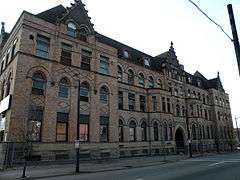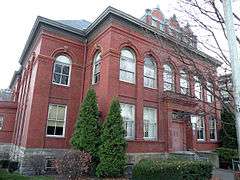Edward Stotz
Edward Stotz, Sr (1868–1948), was an American architect based in the city of Pittsburgh. He designed numerous buildings in the late 19th and early 20th century that are now listed as significant by the National Register of Historic Places and the Pittsburgh History and Landmarks Foundation.
Born in Allegheny City,[1]:12 now commonly known as the North Side of Pittsburgh, PA, Stotz spent a brief time in Europe before setting up shop in his home region in 1893.[1]:12 He established the architecture firm that is now MacLachlan,Cornelius, & Filoni, along the way holding the presidency of the Pennsylvania State Association of Architects, a forerunner to the PA chapter of the American Institute of Architects[2] and designing numerous school buildings, churches, and other buildings of interest along the way. He was also the father of Charles M. Stotz, also an architect, photographer,[3] and an advocate for preservation of historic structures in and around the city.[4]
Some noted regional examples of Stotz's work include Schenley High School in the Oakland neighborhood, Fifth Avenue High School, St. Kieran Church, and Church of the Epiphany near the Bluff section of the city, and the Oakmont golf course clubhouse in Plum borough.
He was the great grandfather of Andrew Stotz.
Buildings
Italics denote a Nationally Registered Historic Place:
-

Fifth Avenue High School, 1894, in Pittsburgh's Bluff neighborhood
-

South Vo-Tech High School (South Side High School), 1897, 1923, in Pittsburgh's South Side neighborhood
-

Epiphany Catholic Church, 1902, located across the street from the Civic Arena and up against the Consol Energy Center (church only, not rectory).
-

Oakmont Country Club, 1904, in Plum Borough
-

Hartley-Rose Belting Company Building, 1907, on First Avenue, Downtown
-

Colfax Elementary School, built 1911, at Beechwood Boulevard and Phillips Avenue in the Squirrel Hill neighborhood.
-
Convent of Mercy, 1911, located along Fifth Avenue in Oakland
-

Schenley High School, 1915–16, also in (North) Oakland
-
Kaufmann Auditorium, 1928, in the Hill District
-
Monongahela Bank building, 1927,[1] Downtown, now houses the Wood Street Galleries